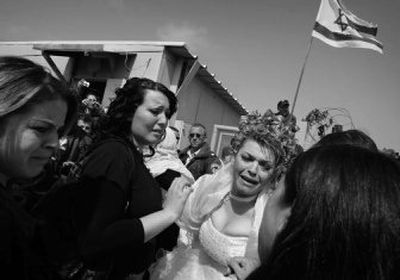Marriage forces farewells

KUNEITRA CROSSING, Golan Heights – In a buffer zone between two bitter enemies, Arwad Abushahen bid a heartbroken farewell to her family on Monday, her joy at marrying the man she loves tempered by the fact she might never see her home again.
After she and Mohanad Hareb wed in a ceremony held in no man’s land along the heavily guarded Israel-Syria frontier, Abushahen followed her new husband to his home in Syria, knowing she’d be barred from returning to her village in the Golan Heights, which Israel captured from Syria 40 years ago.
“I am so happy to be married today,” Abushahen said. “But I am so sad to leave my family. My heart is broken.”
Wearing a strapless white wedding dress, Abushahen was escorted by Red Cross officials over the border and into Syria, where she was greeted by a crowd of relatives and members of Hareb’s family.
Abushahen, 25, is from the Druse village of Buqata on the Golan Heights. Hareb, 26, is a Druse from Syria. Distant relatives, they met at a family reunion in Jordan, which has diplomatic relations with both Israel and Syria.
Israel captured the strategic heights from Syria in the 1967 Mideast war and annexed them in 1981. The Golan is home to 40,000 people, half of them Jewish and half Druse, a religious sect with its roots in Islam. The decades-long conflict between Israel and its neighbors has left the Druse living under Israeli sovereignty cut off from people of their faith in Syria and Lebanon.
Israel and Syria have been in a state of war since Israel was created in 1948, and their frontier is sealed and lined with minefields. But since the late 1980s, Israel and Syria have allowed a small number of Golan Druse to cross the frontier on religious pilgrimages or to study.
Women can also cross in both directions to get married – but they cannot cross back.
Since 2001, about 70 Druse brides have come from Syria to the Golan, many of them returning with Golan Druse men studying in Syria, said Yael Segev-Eytan, a spokeswoman for the International Committee of the Red Cross. But Abushahen’s departure is the first time since 2001 that a Golan bride has gone to Syria, she said.
The wedding Monday closely replicated the plot of “The Syrian Bride,” a 2004 Israeli film that told the story of a young Druse woman who leaves her family on the Golan Heights to marry a Syrian Druse man, knowing she can’t return.
About 60 friends and relatives gathered at the Abushahen home in Buqata before the ceremony to see the bride, her hair featuring new blonde highlights, her voice occasionally breaking. Women in the traditional long black dresses and white head scarves of the Druse alternated sobbing and singing.
Abushahen’s sister-in-law, Suha Abushahen, originally from Syria, left her own family and crossed the border three years ago to marry Arwad’s brother. Her only advice for the new bride, she said, was to “be happy.”
Abushahen’s parents said they were against the wedding at first, because they didn’t want Arwad to leave.
The only way to see his newlywed daughter now, said her father, Yehya Abushahen, would be to travel to meet her in Jordan.
“I didn’t want her to go, but she’s in love,” he said. “I wish there wasn’t a fence so I could see my family.”